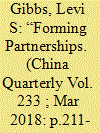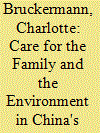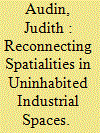|
|
|
Sort Order |
|
|
|
Items / Page
|
|
|
|
|
|
|
| Srl | Item |
| 1 |
ID:
159832


|
|
|
|
|
| Summary/Abstract |
Shortly after a push to promote China's 1950 Marriage Law in 1953, scholars from the Chinese Music Research Institute on a collection trip to a small locality in northern China encountered a large number of folksongs about extramarital affairs. They interpreted this as evidence of the need for marriage reform. The folksong lyrics highlighted controversial aspects of the Marriage Law by espousing one of the law's central tenets – free love – while also expressing women's desires to leave their husbands. In this article, I explore how the researchers placed the song lyrics in a liminal moral-temporal category between “feudal” arranged marriage and the new marriage system before declaring the songs to be relics of the victimization of women in a “feudal” past. I argue that additional light-hearted elements complicate the researchers’ conclusion and suggest that when the promotion of social agendas in the 1940s and 1950s cast songs about illicit affairs as morally ambiguous, Chinese scholars chose to ascribe the songs’ “roots” to other groups or to the “feudal” past of the people they sought to praise and/or transform.
|
|
|
|
|
|
|
|
|
|
|
|
|
|
|
|
| 2 |
ID:
192178


|
|
|
|
|
| Summary/Abstract |
In the “coal province” of Shanxi, residents grapple with tensions between caring for their families and caring about their environment. In creating ethical pathways through care, residents must navigate the paradox of livelihoods dependent on forms of development that endanger lives and pollute environments. This dilemma has crystallized over time, as the personal and particular demands of the present have become enmeshed with long-standing concerns over environmental degradation. Rather than characterizing family care as concrete and environmental care as abstract, acts of care in Shanxi link the reproductive crisis of the family with the reproductive crisis of the environment: the article presents instances under which the attention, empathy and recognition of care for concrete others are scaled up to the levels of ecology and planetary crisis.
|
|
|
|
|
|
|
|
|
|
|
|
|
|
|
|
| 3 |
ID:
106504


|
|
|
|
|
| Publication |
2011.
|
| Summary/Abstract |
The land-locked north China province of Shanxi, identified in 1870 by the geologist Baron Richthofen as 'one of the most remarkable coal and iron regions in the world', was the site of a provincially-defined national movement far removed from the better-studied treaty ports and their articulate and prolific nationalists. This late-Qing provincialism may be read as a mediating symbol of an emerging national consciousness.
Social tensions were exacerbated by external challenges brought by foreign agents, and their Chinese collaborators, of cultural and economic imperialism. Opposition to missionaries and Chinese Christians had begun as early as the 1860s. In 1898 the British Pekin Syndicate and its extra-provincial Chinese associates, with the backing of the central government, secured rights to Shanxi's rich coal and iron resources. These rights were ceded back ten years later after a successful 'rights-recovery' movement that possesses similarities to (but also significant differences from) the well-studied oppositional movements in Jiangsu, Zhejiang, Hunan, and Shandong in the period 1905-1911. The duration of Shanxi's struggle, along with its extra-bureaucratic elite activism, popular mobilization, and cooperation with Beijing, makes its rights-recovery movement distinctive. The rhetoric and practices of the movement, which began before the Boxer Uprising of 1900 and reflects the rhetorical influence of these earlier protests, contributed to a strong regional solidarity that was backed by central state authority. There were various patterns of protest, one indigenous and provincial, one extra-provincial and nationalist, that interacted in the period 1902-1908. Provincial activists, including merchants, peasants, students, degree-holders, and officials, insisted that Shanxi's coal was for the use of the community, the province, and the nation on terms established by and for the people of Shanxi. In their victory, localism, provincialism, and the national project, had come together.
|
|
|
|
|
|
|
|
|
|
|
|
|
|
|
|
| 4 |
ID:
182942


|
|
|
|
|
| Summary/Abstract |
Far from dense Chinese cities that experience fast demolition, ruination in Kouquan, a coal town in Datong, is a slower process that generates new practices and meanings. Uninhabited industrial spaces continue to produce a sense of place where large industrial corporations no longer operate and where most residents have moved away. This article brings out new perspectives on the effects of ruination in an industrial area by moving away from the lenses of the work unit, demolition, heritagisation, or decline. Based on direct observation, informal discussions with local residents from 2016 to 2019, and an online review, this article shows that ruination produces spatialised narratives and practices closely entwined with the local population’s experiences, as well as with other actors’ direct and indirect interactions with places: these actors reconnect to the uninhabited town through dwellings, artistic production, religious practices, or simply through their visits to Kouquan, becoming urban explorers themselves. Ruination leads remaining residents, former locals, visitors, government actors, journalists, and artists to the production of new representations of the uninhabited town.
|
|
|
|
|
|
|
|
|
|
|
|
|
|
|
|
|
|
|
|
|